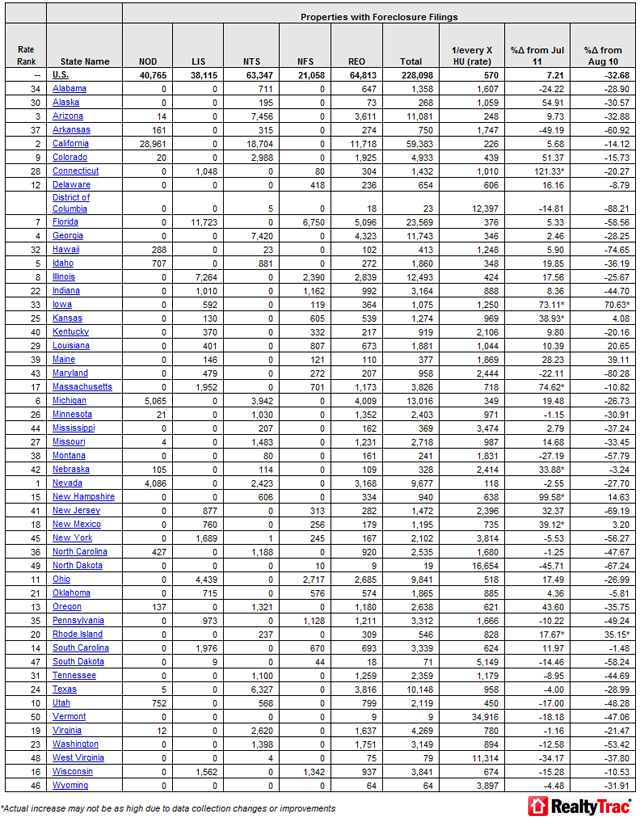Foreclosure filings spiked during August, driven by a large increase in early-stage filings according to the U.S. Foreclosure Market Report released by RealtyTrac on Thursday. While the month-over-month increases were substantial, the levels of filings in all categories are well below those one year ago.
RealtyTrac, an Irvine California firm tracks foreclosure filings in three categories:
1. Notice of Default (NOD) and Lis Pendens (LIS). This is the first legal notification from a lender that the borrower on a mortgage loan has defaulted under the terms of their mortgage and the lender intends to foreclose unless the loan is brought current.
2. Auction - Notice of Trustee Sale and Notice of Foreclosure Sale (NTS and NFS): if the borrower does not catch up on their payments the lender will file a notice of sale (the lender intends to sell the property). This notice is published in local paper and contains information pertaining to the date, time and subject property address.
3. Real Estate Owned or REO properties : "REO" stands for "real estate owned" and typically refers to the inventory of real estate that banks and mortgage companies have foreclosed on and subsequently purchased through the foreclosure auction if there was no offer higher than the minimum bid.
August filings across all three categories increased 7 percent from July and involved a total of 228,098 properties or one in every 570 U.S. housing units. This is down nearly 33 percent from filings in August 2010. Default notices increased 33 percent compared to July, the largest monthly increase since August 2007. Notices of Default or Lis Pendens were filed on 78,800 houses, 44 percent below the peak of 142,064 filings in April 2009 and down 18 percent from the August 2010 number.
"The big increase in new foreclosure actions may be a signal that lenders are starting to push through some of the foreclosures delayed by robo-signing and other documentation problems," James Saccacio, chief executive officer of RealtyTrac said. "It also foreshadows more bank repossessions in the coming months as these new foreclosures make their way through the process."
Foreclosure auctions were scheduled for the first time on 84,405 properties, down one percent from July and 43 percent from the same period in 2010. This was the lowest figure for this category in over three years and 47 percent off the peak number of auctions scheduled in March 2010.
Lenders completed foreclosures on 64,813 properties in August, down 4 percent from July and 32 percent from a year earlier and achieving a six month low in this category. At the peak of activity last September, the month before the nationwide robo-signing problems came to light effectively halting foreclosures, lenders repossessed 102,134 properties.
There was little change in the ranks of states with the highest foreclosure rates. Nevada was the most active state for the 56th straight month with one out of 118 housing units receiving a filing. Arizona and California continued to swap off second and third places; California is now second with one in 226 units affected while Arizona saw filings on one in 248. All three states are trending downward in overall foreclosure activity although Arizona and California saw substantial monthly increases in some categories. Other states ranking high in overall foreclosure activity were Georgia, Idaho, Michigan, Florida, Illinois, Colorado, and Utah.
The monthly count of default notices increased more than 40 percent in several states, including New Jersey (42 percent), Indiana (46 percent) and California (55 percent), and scheduled auctions were up substantially in Oregon (19 percent), Arizona (20 percent), Georgia (22 percent), and Colorado (51 percent.) In each case the activity was still well below August 2010 levels.
Several large metro areas, almost all in California, saw double-digit increases in default notices in August. The increase in Visalia-Portervile, California was 97 percent and Fresno, California 95 percent. With the exception of Stockton, California's 7 percent increase, the other cities in the top 10 had monthly increases of 44 percent or more.








